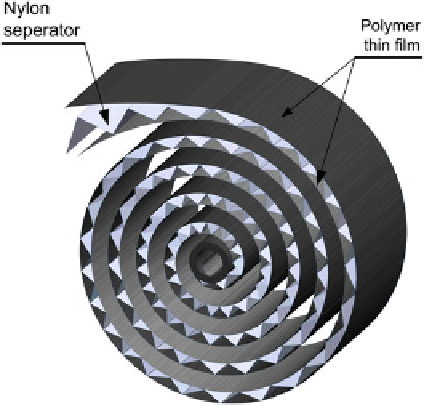Environmental Engineering Reference
In-Depth Information
Fig. 10.23 Spiral stack made
of layers of polymer and
nylon separator (see also
Olsen et al. [
81
])
thereby heating up the stack of the pyroelectric material (Fig.
10.22
a). After the
fl
uid had been pumped from the heat sink to the heat source, thereby cooling down
the stack of pyroelectric elements, the voltage was decreased from the high value to
the low value (Fig.
10.22
b). The stack of pyroelectric elements was constructed
from Pb
0.99
Nb
0.2
(Zr
0.68
Sn
0.25
Ti
0.07
)
0.93
O
3
(PZLT) ceramic plates with dimensions
of 24
0.25 mm
3
. Wires were soldered to the electrodes of each ceramic plate
and 24 of such assemblies created a porous stack with a 0.25-mm gap between the
pyroelectric elements. The electrically wired pyroelectric stack was connected to a
measurement system to measure the generated pyroelectric current and the voltage.
Based on the measured current and the voltage, an electrical energy of
0.31 J
×
×
24
cycle
−
1
/L of the pyroelectric material) was calculated. The
temperatures of the heat source and the heat sink were 178 and 145
cycle
−
1
(130 J
·
·
°
C, respec-
eld was varied between the high value of 3.2 MVm
−
1
and
the low value of 0.4 MVm
−
1
. The frequency of the device was 0.128 Hz and the
electrical power output was 40 mW. The heat input of the electrical heater was
9.6 W and, accordingly, the ef
tively, and the electric
ciency of the device was 0.42 %.
Olsen et al. [
81
] performed an additional experiment, similar to the one
described above; however, in this case a polymer pyroelectric material P(VDF-
TrFE) was used. The polymer material was formed in a spiral stack that was
constructed from layers of the polymer pyroelectric material. Between the layers of
the polymer material a nylon separator was inserted to create a void for the
fl
uid
fl
ow (Fig.
10.23
). The results of the experiment showed that in comparison with the
PLZT-based pyroelectric stack, the produced electrical power of 30 J
cycle
−
1
/L of
the pyroelectric material was almost an order smaller. The temperatures of the heat
sink and the heat source were 23 and 67
·
°
C, respectively, and the electric
eld was
varied between approximately 22.5 and 53 MVm
−
1
.

Search WWH ::

Custom Search